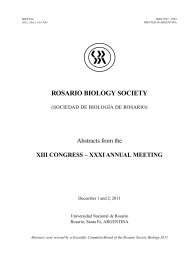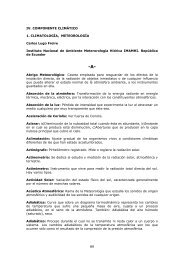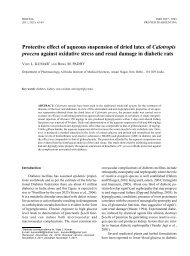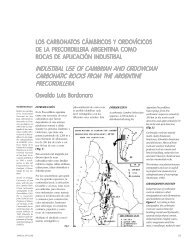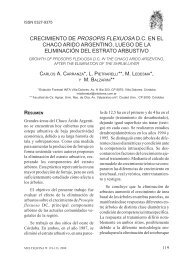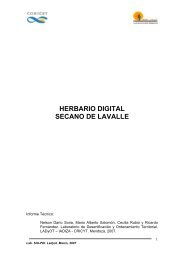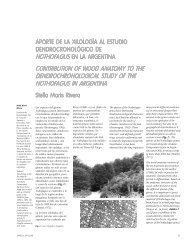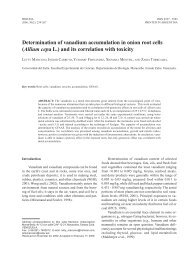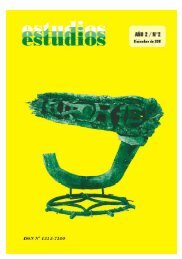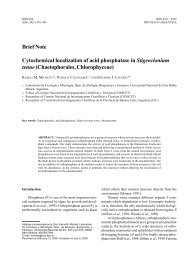XXII Annual Scientific Meeting, Tucuman Biology Society ...
XXII Annual Scientific Meeting, Tucuman Biology Society ...
XXII Annual Scientific Meeting, Tucuman Biology Society ...
You also want an ePaper? Increase the reach of your titles
YUMPU automatically turns print PDFs into web optimized ePapers that Google loves.
174 ABSTRACTS<br />
33.<br />
CLINICAL ALTERNATIVE TO REESTABLISH BIOLOGI-<br />
CAL SPACE. PRELIMINARY CLINICAL STUDY<br />
Valdivia G, Montero CA, Ballesteros G, Aragón HN, Gordillo ME,<br />
Loi JA.<br />
Periodontics Chair, University of Odontology, U.N.T. (National<br />
University of Tucumán). E-mail: joseloi@odontologia.unt.edu.ar<br />
Biological conditions represent the key factor for the clinical treatments<br />
of periodontitis. Several authors reported non -surgical and<br />
surgical treatments. Objectives: preliminary information about a<br />
non-invasive procedure, preserving a normal area which allows the<br />
reinsertion of collagen and the adhesion of the epithelium union,<br />
thus re-establishing the biological space in a new position. Materials<br />
and Methods: seven single permanent roots were selected, in<br />
which forceps were used for their luxation and supragingival removal;<br />
then they were splinted in a semi -rigid way. Clinical records<br />
were taken in relation to the gingival margins of neighbour teeth.<br />
The radiographic measures registered the distance between alveolar<br />
bone crest and the enamel -cement limit in mesial and distal<br />
relation to the neighbour teeth. Results: with Friedman test (p ><br />
0.05) no significant changes were seen. Radiographic analysis (twoway<br />
ANOVA), didn’t show changes between groups neither (p ><br />
0.05). The mobility variable doesn’t show any change after 60 days.<br />
Conclusions: this technique preserves aesthetics, biology, and can<br />
be performed by the general dentist.<br />
Subsidized by C.I.U.N.T. (Investigation Center of the National University<br />
of Tucumán).<br />
34.<br />
REPRODUCTION IN MARSUPIAL FROG Gastrotheca<br />
christiani (Amphibia, Anura)<br />
Pucci Alcaide A, Alcaide M.<br />
Fundación Miguel Lillo, Tucumán. 4000.<br />
E-mail: felisaalcaide@hotmail.com<br />
Gastrothece Christiani has a particular reproductive mode, his eggs<br />
are carried in a female dorsal incubatory pouch, form by a skin<br />
fold. This paper is the histomorphological and histochemical study<br />
of the ovary, oviducts, and the embryo development in the pouch;<br />
in order compared with other species of the Gastrotheca. The ovary,<br />
oviducts and embryos are fixed in Stieve and were colored with H-<br />
E, TB pH5,6; AB pH 2,5 and 0,5 combined with PA-Schiff. In the<br />
ovary are oocytes in differents states. The stroma is abundant with<br />
dense connective tissues, collagen fibers and follicles in different<br />
stages of vitelogenic development; vascular-nervous packages and<br />
thecals. Between the oocytes are MEC of proteics with some lipidic<br />
vacuoles and oocytes in degeneration. Beside that we can find<br />
proteins liquidicated component. It was observed only one atresic<br />
follicle and a lutheum corpora. Folds with metacromatic-globed<br />
cells form the oviducts with sulphated groups. Under the epithelium<br />
we can find a dense and highly vascularizated connective tissue<br />
with a few mucosae glands. The incubatriz pouch is<br />
vascularizated thin skin fold with a stratificated epithelium and<br />
mucosae glands. The embryos are in different developments stages.<br />
It was observed; notochord, cartilage, muscles and some organs of<br />
the digestive. Also we can observe great quantity of yolk in order to<br />
achieve the embryos development to a mature stage; because this<br />
specie has a direct development they will born as juvenile individuals.<br />
Conclutions: There are a few oocytes in the pouch. Ovaries and<br />
oviducts are different to species with other ovipositions modes.<br />
BIOCELL 30(1), 2006<br />
35.<br />
INHIBITION OF PATHOGENS ASSOCIATED WITH<br />
RED-LEG SYNDROME BY Enterococcus faecium STRAINS<br />
Pasteris SE 1,2 , Roig Babot G 1 , Bühler MI 1 , Nader-Macías ME 2 .<br />
1 INSIBIO-UNT and 2 CERELA-CONICET. Chacabuco 461. C.P.<br />
4000. Tucumán. E-mail: pasteris@fbqf.unt.edu.ar<br />
The commercial trade of Rana catesbeiana could be influenced with<br />
epizootic such as red-leg syndrome (RLS) which causes mortality in<br />
hatcheries. The utilization of probiotics represents an alternative to the<br />
use of antibiotics and vaccines. In previous works we studied the beneficial<br />
properties of Lactobacillus isolated from different areas of a hatchery.<br />
The aim of this work was to study the inhibitory properties of Enterococcus<br />
faecium strains against pathogens related with RLS: Proteus<br />
vulgaris, Pseudomonas aeruginosa, Citrobacter freundii. Listeria<br />
monocytogenes. and Salmonella enteritidis were included as meat spoilage.<br />
Inhibitory properties were performed by the well difusion method<br />
by using supernatants of overnigth Enterococcus cultures at 37°C. E.<br />
faecium MCH 18a and MCH 22c isolated in september from healthy<br />
animals inhibited all pathogens associated with RLS and L.<br />
monocytogenes while one strain isolated from non-healthy animals inhibited<br />
Ps. aeruginosa, pattern observed also in a strain from freswater<br />
samples. From 27 strains isolated in december, only E. faecium GST 38<br />
(isolated from balanced feed) inhibited RLS-related pathogens and L.<br />
monocytogenes. The lost of inhibition observed after neutralization of<br />
the supernatants as well as the low pH values indicated that the inhibition<br />
was produced by acidity. However, L. monocytogenes was also inhibited<br />
by hydrogen peroxide. In these work we select a group of E.<br />
faecium strains to study other beneficial properties in order to design a<br />
probiotic for aquaculture.<br />
36.<br />
NEUTROPHILS WITH TOXIC GRANULATIONS IN<br />
NORMAL PREGNANT WOMAN<br />
Lazarte S, Leri M, Agüero G.<br />
Instituto de Bioquímica Aplicada, FBQF, UNT. Balcarce 747. San<br />
M. de Tucumán. E-mail: gaguero@unt.edu.ar<br />
The toxic or coarser granulation (TG) is the word that describe the<br />
increase of density and possibly in the number of primary granulations<br />
of neutrophils, that becames a great staining with the Giemsa<br />
reactive. They can appear in infections, inflammation or intoxication.<br />
Aim: to study the presence of TG in normal pregnant woman<br />
in different periods of gestation. We realized micro-hematocrit determination,<br />
the total an differential count of leukocytes (40x) and<br />
the search of TG by optic microscope (100x), in 50 pregnant patients.<br />
Three groups of 10 patients were chosen in aleatory way,<br />
corresponding to 1°, 2° y 3° trimester of pregnancy, with an average<br />
of age from 20 to 42 years old. Results:Hto (%):T1°=39,8±3,9;<br />
2°=37,6±3,8; 3°=39,1±4.4. Leukocytes (10 9 /l):T1º=7,68±1,1;<br />
2°=9,35±2,07 y 3°=10,42±2,26.<br />
Neutrophil(%): T1°=68±4 ; 2°=68%±9 ; 3°=69±9. TG:4/10, , 6/10<br />
y 7/10 pregnant woman of 1°,2° and 3° trimester respectively, presented<br />
TG. It could see an important association (p



